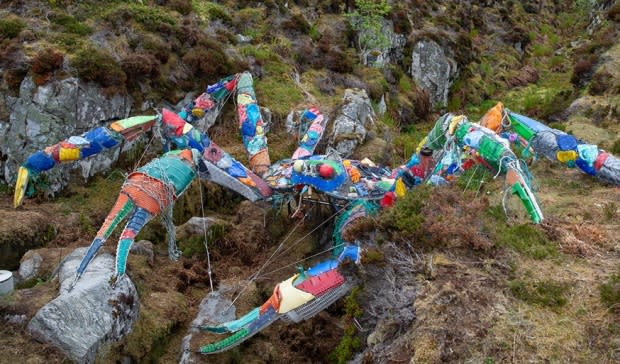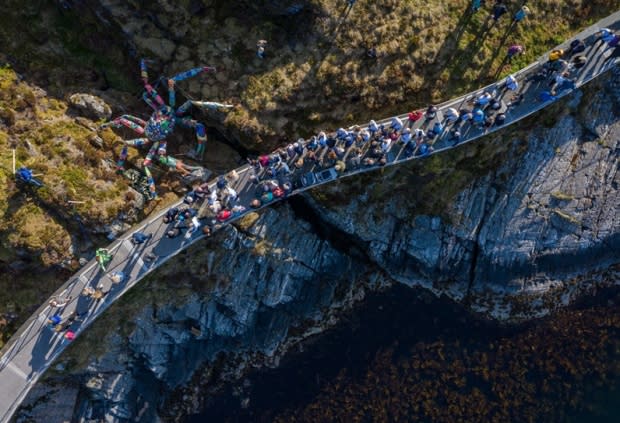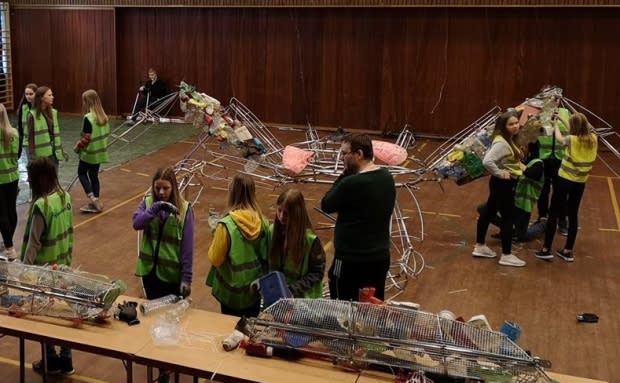Norwegian artist builds giant crab out of plastic trash, inspired by N.L. scientist

Perched over a crevice next to a coastal trail on the western tip of Norway sits a giant, plastic crab — and it's there partly thanks to Newfoundland.
Norwegian artist Eirik Audunson Skaar enlisted the help of Grade 8 and 9 students at a secondary school in Averøy to comb the shoreline for plastic garbage, material they would analyze and talk about — and use to build the huge snow crab.

The idea came after watching a video of underwater garbage around wharfs in Newfoundland shot by DFO scientist Corey Morris.
"I saw Corey's work on the net and it was so interesting and amazing," said Skaar, who saw a way to teach students about environmental issues.
"The youth have a very intuitive relation to the environment. It's nothing strange for them to engage in these issues; they are naturally interested in keeping the world and the oceans in a clean state. They want to preserve nature."
The snow crab is eight metres wide, with a steel frame liberally adorned with pop bottles, margarine containers, fishing gear and whatever else washes up on the beaches.

Morris says he spent 10 years surveying harbours around Newfoundland, measuring debris, most which came from households, various single-use plastics and the fishing industry.
It was after the media reported on the underwater garbage that Morris got the call from Skaar.
"I realized the type of garbage that he was finding, it was pretty much exactly the same things that we see here: fishing gear, single-use plastics, household garbage, things that are thrown into the ocean," said Skaar. "We have pretty much the exact same contents in the ocean that they're picking off their beaches over there, over here."

It's not just the same type of garbage as in Newfoundland and Labrador, he said, but in some cases it's actual garbage from the province — such as lobster tags — that is ending up on beaches in Norway.
Skaar and Morris now hope to inspire students in Newfoundland and Labrador to pick up plastic, analyze it and create a crab like students did in Norway.
"We make everyday trash into something uncommon, something unreal," said Skaar. "We make the familiar unfamiliar. We make people look again at everyday trash and have a thought or two about what it really is, where it comes from, who once owned it and what happened."
Plans for N.L. version
Skaar and Morris met with a Grade 4 class at Beachy Cove Elementary recently to talk about the project.
"We met some amazing kids. They strongly advised me to next time make a turtle or a seal," he said. "But this time we make a crab and one of them wanted to borrow the crab and use it in the Christmas parade. So they have ideas already. I think this is rolling."
Skaar's crab was paid for mainly through a fund that collects a five-cent environmental fee on every plastic bag sold in Norway. In Newfoundland and Labrador, the provincial chapter of non-profit organization Zero Waste Canada will lead fundraising efforts to make the project happen.
The steel structure of the crab will be built in Norway and shipped to Newfoundland in the spring.

Viviana Ramirez-Luna, Zero Waste Canada's N.L. representative, said there's a lot of interest in the project here.
"There's a lot of people already as we know working on, you know, research, conservation and education," she said. "So my role is to bring all those people together, how we can work together"
Ramirez-Luna's group will organize beach cleanups and, with local schools, use the collected plastic to cover the crab shell.
The location for the crab in N.L. hasn't been settled yet, but once the crab is constructed, it, like its Norwegian counterpart, will face the Atlantic Ocean.
Read more from CBC Newfoundland and Labrador


